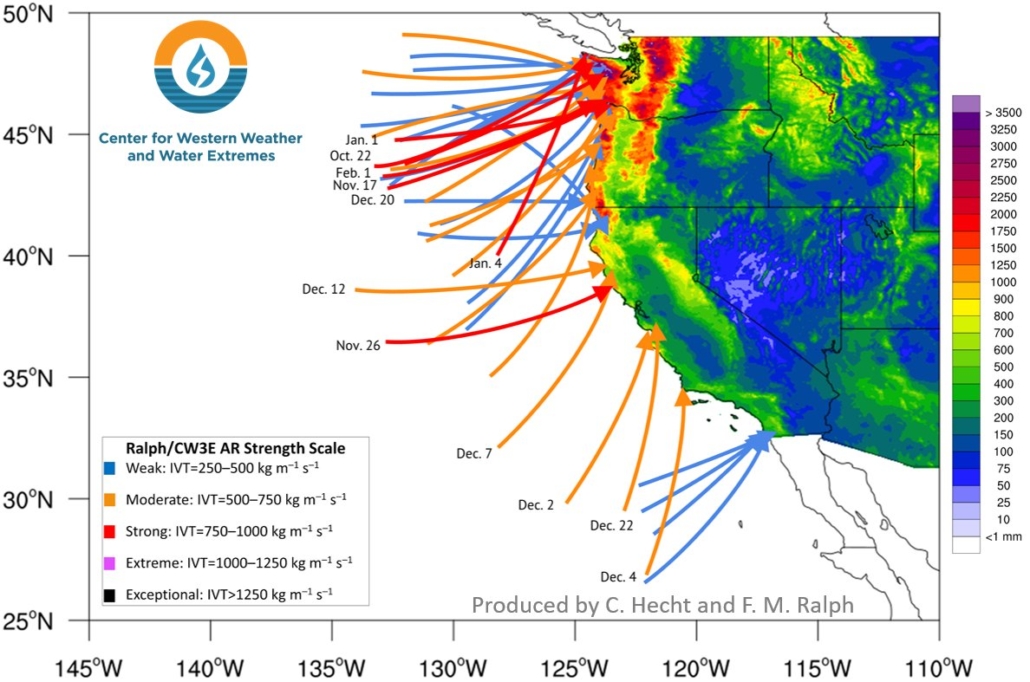After Last Week’s Storm, April is Already 3rd Wettest Month on Record
Although a mere 13 days old, this is the third-wettest April on record in San Diego, the National Weather Service reported Monday.
Although a mere 13 days old, this is the third-wettest April on record in San Diego, the National Weather Service reported Monday.
More than three dozen atmospheric rivers made landfall on the West Coast from fall through early spring, but a lack of strong events in California led to the development of drought conditions in parts of the state.
An atmospheric river is a thin, but long plume of moisture in the atmosphere that stretches from the Pacific Ocean tropics or subtropics into higher latitudes. They provide a boost to the rain and snow totals produced by storm systems taking aim at the West Coast, mostly from late fall into early spring. Although these events can bring hazardous impacts, they are also beneficial since they help replenish the water supply in the West.

The Center for Western Weather and Water Extremes at Scripps Institution of Oceanography studies atmospheric rivers and other extreme weather. Graphic: CW3E Scripps/UC San Diego
A Pacific storm that was expected to drop about 1.5 inches of rain along the San Diego County coastline has produced more than twice that much and will continue to wash across the region until Friday night, according to the National Weather Service.
The system arrived in force on Sunday and was supposed to be gone by Wednesday night or Thursday at the latest.
“But it’s been sitting and spitting over us all week”, said Miguel Miller, a weather service forecaster “The models have it moving out pretty quickly on Friday night.”
San Diego International Airport unexpectedly received about 1.50 inches of rain overnight. By 6 a.m. Friday, the airport’s seasonal rainfall total had hit 12.54 inches, more than three inches above average.
U.S. Drought Monitor data released Thursday show that less of California is abnormally dry, and more of the state is drought-free.
The improvement is mostly in Southern California and along the Central Coast, while data for Northern California show little change.
Rain and snow continued to fall Thursday on parts of California as a wet spring following a no-show winter pushed back against resurgent dryness that spread over three-quarters of the state this year.
Mountain peaks from the Sierra Nevada to major ranges crossing Southern California glistened with new coats of white as hillsides sported increasingly vivid shades of green fueled by precipitation that began in March after a largely withering January and February.
The latest storm entered the state from the north last weekend and slowly moved down the coast.
Heavy rain will fall at times in San Diego County Thursday evening and snow is likely in the mountains, according to the National Weather Service.
As of 1 p.m. Wednesday, 5 inches of snow had fallen on Palomar Mountain. Palomar Mountain is expected to get up to 3 more inches of snow by late Friday morning, while Mount Laguna could get between 6-7 inches and Julian could get trace amounts of snow, meteorologist Miguel Miller said. Snow levels will be around 4,900 feet Thursday morning, then rise to 5,500 feet by this afternoon and remain there through Friday morning.
A flash flood watch is in effect throughout the county until Friday afternoon.
The San Diego region is being drenched by a rare spring storm system, but all that moisture isn’t adding much to the region’s supply of drinking water.
The snow was falling in the San Diego county mountains on Wednesday, pretty heavily in some places.
That comes courtesy of a slow-moving cold storm system coming into the region from the north.
The region’s National Weather Service office called this prolonged six-week run of rain in March and April, pretty rare for the region.
No ‘March Miracle’ for snow and rain in California, but the San Diego County Water Authority has diversified water supply sources to weather the boom-and-bust cycle of California winters.
March brought abundant precipitation throughout California, but not enough to offset a dry February. Most large urban water agencies in the state maintain a reliable water supply in wet and dry years.
In the rolling hills of Fallbrook, California, Joseph Rossi and his family have been growing avocados at Rossi Ranch for 23 years.
The fruit has become so popular they now rely on their farm alone to make a living.
“It’s 100 percent of our income for the past seven years now,” Rossi said.